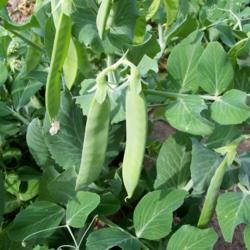
"Raised bed" is a term used when soil is raised so that the seedbed is higher than the soil in the adjacent walkways.
Advantages of Raised BedsHere are several reasons why growing on raised beds is beneficial for peas.
You can plant earlier in the spring because the soil on a raised bed warms up and dries out faster than it does in the rest of the garden.
You'll have better drainage because rainwater runs off into the walkways, eliminating the problem of water standing too close to the plants' roots. The better your garden drains, the fewer diseases your plants will develop.
You can irrigate more easily. Simply run water from a hose between the beds and allow the water to seep into the root zone. Raised beds are an especially good idea if you live in a dry area or if you have a dry spell.
Preparing Raised BedsPreparing raised beds is worth the extra time and effort. Here's what you need to do.
 Victory Seed Company has all the seeds you want for your best garden in 2024.
Victory Seed Company has all the seeds you want for your best garden in 2024.
For 25 years, the family-owned Victory Seed Company has provided the highest quality vegetable, herb and flower seeds to families across the country. We are passionate about providing you the best seeds available that give excellent germination, robust plants, and the harvest you want. With a catalog of over a thousand varieties, we have everything, and our prices are the kinds that we'd want to pay. We have hundreds of yesterday's heirloom vegetables, as well as today's award winning hybrid selections. Get to know us by visiting our website and browsing through our online vegetable seed catalog.
| 1. Preparing to Plant Peas |
| 2. Choosing Pea Varieties |
| 3. Perfecting Your Soil for Peas |
| 4. Growing Peas in Raised Beds ← you're on this article right now |
| 5. About Peanuts |
| 6. How Peanuts Grow |
| 7. Planting Preparation for Peanuts |
| 8. Pea Essentials |
| 1. Preparing to Plant Peas |
| 2. Choosing Pea Varieties |
| 3. Perfecting Your Soil for Peas |
| 4. Growing Peas in Raised Beds ← you're on this article right now |
| 5. About Peanuts |
| 6. How Peanuts Grow |
| 7. Planting Preparation for Peanuts |
| 8. Pea Essentials |